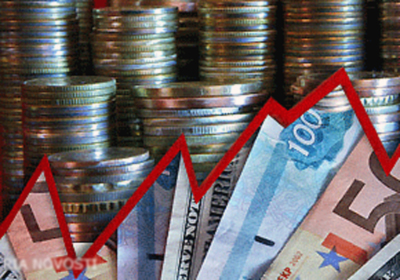Half of Russia Still in Crisis Prepares for Worse to Come

(Bloomberg – bloomberg.com – Olga Tanas – February 20, 2017)
The half of Russia’s economy that hasn’t got wind of a recovery is already hunkering down for the crisis to come.
Once indispensable for the country’s prospects, consumption flat-lined well below zero throughout last year even as the broader economy defied gloom. From the ruble to industrial output and wages, the outlook is brighter.
But that isn’t filtering through to consumer spending, which accounted for 52 percent of the $1.5 trillion economy last year. A Levada Center survey conducted last month found that 78 percent of Russians believe the country is heading for an economic crisis, an increase from 74 percent in September.
Data due Tuesday or Wednesday will show retail sales shrank for a record 25th month in January, while a decline in real disposable incomes extended into a second year. Each lost more than 5 percent in 2016, compared with a contraction of only 0.2 percent in gross domestic product.
“The main reason for such divergence is the persistent decline of broader real disposable incomes, which remain constrained by a continued decline in pensions and social transfers in real terms,” Vladimir Osakovskiy, chief economist for Russia at Bank of America Corp. in Moscow, said in a report. “Incomes should resume growth in 2017.”
Some help is already on the way. A decline in inflation, set to decelerate to a historical low this year, is restoring purchasing power. A one-time payout to retirees in January, in addition to an adjustment in average pensions this month, will further fortify household finances.
The Russian currency continued to appreciate in 2017 after its best-ever year in 2016, when it gained 20 percent against the dollar. It’s up almost 6 percent so far this year.
Getting people to open up their wallets, however, is a tall task when they fear another economic meltdown may be just around the corner. While real wages probably grew for sixth consecutive month in January, retail sales dropped 5.1 percent from a year earlier after a decrease of 5.9 percent in December, according to the median estimates of economists surveyed by Bloomberg.
Asked how they’d manage an addition to family wealth equal to two months of income, 50 percent of Russians said their choice would be to save the money, up from 47 percent who gave the same answer a year earlier, according to a poll conducted last month by inFOM for the central bank. Among the respondents, 65 percent said their earnings didn’t grow over the past year but prices did.
Adjustments have been extensive for Alexander Fedorov, a 40-year-old head of a legal firm in Moscow. His family isn’t borrowing as much it used to, and it’s cut back on expenses ranging from fish and gadgets to eating out and entertainment.
‘Less Certainty’
“There is less certainty in tomorrow,” he said. “Previously we were much more optimistic, but now confidence in tomorrow’s income has fallen. However, despite everything, there’s now a desire to save, while previously we only spent money.”‘
That’s music to the ears of the Bank of Russia, which has kept its policy “moderately tight” to encourage savers and is on the lookout for threats to inflation. It’s targeting price growth at 4 percent in 2017, compared with 5 percent in January.
The central bank’s research and forecasting department has also raised questions about the statistics service’s methodology, which it believes may currently underestimate retail sales.
GDP data has already been revised to show that Russia’s recession was more shallow than previously estimated, with the extent of the economic contraction in 2015 changed to 2.8 percent from 3.7 percent. The statistics service said it’s now using a new method as part of its shift toward international standards.
Retail data may also be revised, according to the Federal Statistics Service. Using the new classifications, it already updated its industrial production numbers stretching over the past two years. An unusual release on Saturday, delayed from last week, showed industry had a decline of only 0.8 percent in 2015, compared with a previous estimate of 3.4 percent, while growth in 2016 was recalculated to 1.3 percent from 1.1 percent.
Better Performance
“With the new methodology, it’s a bit tricky to reconcile the data,” Dmitry Polevoy, economist for Russia at ING Groep NV in Moscow, said by e-mail. “But the message is clear — the scale of recession in the economy overall and in the industrial sector specifically has been less pronounced than we expected.”
The spirit among shoppers is lifting, and it shows in parts of the retail industry. The average check at Magnit PJSC, one of Russia’s biggest supermarket chains, increased by 0.6 percent in the fourth quarter from the same period a year earlier. Consumer confidence improved to the highest in two years last quarter.
While people can afford to meet their current needs, the rest is off limits. That leaves them in a state of “dignified poverty,” according to Marina Krasilnikova, head of the department on research into consumption and living standards at Levada Center, an independent polling organization in Moscow.
Only about a third of the population has savings, which rarely exceed six months of household income. Remuneration and social payments, in particular pensions, remain the main source of earnings, she said.
That “makes people passive hostages of the current economic situation,” Krasilnikova said at this month’s annual Levada conference.
Article ©2017 Bloomberg L.P. All Rights Reserved. Article also appeared at bloomberg.com/news/articles/2017-02-19/the-half-of-russia-still-in-crisis-prepares-for-worse-to-come
